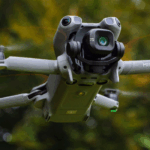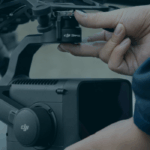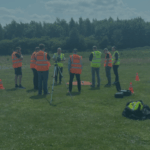Drones have proven themselves to be incredible tools in a variety of industries, revolutionising the way we capture data and conduct operations. Yet, after over a decade in the drone industry, it continues to amaze me how organisations, despite embracing the potential of drone technology, still struggle to realise the full return on investment (ROI) that drones can offer.
The core of this challenge, I believe, lies in a constrained perspective—a tendency to think inside the box—focusing on the immediate capabilities of drones without appreciating the broader impact they can have on data-driven decision-making and operational efficiency.
The Challenge: Sifting Through the Data Deluge
One of the primary reasons organisations are failing to maximise their drone ROI is the sheer volume of data generated. Drones can collect massive amounts of information in a short amount of time, but separating valuable insights from the noise can be overwhelming. This data deluge makes it difficult for organisations to focus on the key metrics that truly drive value, often leading to missed opportunities in optimising drone operations and integrating them more effectively into the broader business strategy.
A Journey Through Best Practices
To illustrate how drones can be used to their full potential, I want to share a couple of examples from my experience in the industry. At Iprosurv, we have seen firsthand how a comprehensive approach to drone adoption can lead to significant returns—both financially and operationally. Our aim has always been to ensure that any customer or organisation interacting with our drone capabilities understands the true ROI, whether it’s through on-demand inspection services, identifying use cases and applications through consultancy, or managing internal teams to support the deployment and utilisation of drone technology within an organisation.
Broader Impact: Environmental and Operational Efficiency
In 2023, we focused on monitoring our operational efficiency and environmental impact, not just through inspection requests but also by optimising our broader operational network. A key initiative was reducing the miles traveled by our teams, which totaled 139,214 miles. By cutting down on unnecessary travel, we were able to save significant amounts of fuel and reduce carbon emissions. To put this into perspective:
Environmental Savings: By avoiding these miles, we saved around 25.06 metric tons of CO₂ emissions. To visualise this, it’s equivalent to the carbon absorption of 1,137 mature trees over a year or the emissions from nearly 14.7 round-trip flights from London to New York.
Cost and Time Efficiency: The cost savings were also substantial. With an average fuel efficiency, this reduction in travel saved approximately £23,728.02. Moreover, the time saved by not traveling this distance—estimated at around 2,780 hours, or 115.8 days—allowed our teams to focus on higher-value activities.
These seemingly minor adjustments have compounded into significant environmental and financial benefits. The takeaway here is clear: by carefully managing drone operations, organisations can achieve substantial efficiency gains and contribute to sustainability goals and maximising their ROI.
Effective Response: The Jersey Village Case
Another compelling example of the transformative potential of drones comes from a recent project in a village in Jersey, where over 50 houses had suffered damage from a hurricane. Faced with the challenge of assessing widespread damage efficiently, the client engaged Iprosurv to collect a single, comprehensive digital data set. This data provided diverse insights, capturing not only the extent of property damage but also the condition of vehicle assets affected by the storm.
The client then shared this data set with multiple contractors, enabling them to commence initial scoping exercises without the need for multiple site visits. This streamlined approach not only eliminated the need for repeated travel but also significantly reduced decision-making time. At a moment when resources across the island were severely stretched, this method proved invaluable, ensuring that repairs could be planned and executed more efficiently and effectively.
Coordinated Action: The Wennington Fire Incident
The impact of drones on operational efficiency can also be seen in the response to the Wennington fire. When the fire occurred, dozens of stakeholders—including including surveyors, brokers, loss adjusters, building contractors, structural engineers, and also specialists in motor and agriculture. Traditionally, this would have resulted in larges numbers of stakeholders on site, each trying to gather their own data.
However, by utilising a drone-generated digital twin of the site, Iprosurv was able to provide a single, comprehensive data set accessible to all stakeholders. This approach enabled each team to independently analyse the information and make informed decisions from a centralised source. As a result, the need for multiple site visits was eliminated, significantly reducing travel and logistical costs while accelerating the decision-making process. This not only saved time and resources but also ensured a more coordinated and effective response to the disaster.
Ensuring ROI Across the Supply Chain
To replicate these results across the supply chain, organisations must embrace change management and commit to continuous improvement. This means rethinking traditional processes and encouraging a culture of innovation where decisions are data-driven and collaborative.
The Jersey Village and Wennington Fire examples highlight how a unified approach to drone data can lead to significant improvements in efficiency and decision-making. By adopting similar strategies, organisations can ensure that they are maximising the ROI from their drone investments and driving value across their operations.
The Path Forward
To truly unlock the ROI of drones, organisations need to step outside the box. This means embracing a broader view of how drone data can be used, investing in data management and analysis tools that separate the signal from the noise, and fostering a culture of collaboration and innovation. By doing so, the potential of drones can be fully realised—not just as a tool for capturing data, but as a catalyst for transformative change across industries. As we continue to explore the capabilities of drones, the key will be not just in how we use the technology, but in how we integrate it into the very fabric of our operations, maximising both its immediate and long-term impact.
Unlock the Full Potential of Your Drone Investment with Iprosurv
At Iprosurv, we specialise in helping businesses maximise their drone ROI through tailored solutions and expert consultancy. Whether you’re looking to streamline operations, enhance data-driven decision-making, or reduce your environmental footprint, our team is here to guide you every step of the way.
Author: Rebecca Jones Co-Founder






